Virtual Cameras
Lumeo Virtual Cameras let you deploy analytics to video clips uploaded from cameras using SMTP, FTP, or via API
Lumeo Virtual Cameras (previously known as Universal Bridge) allow you to add a wide range of cloud-based, AI-powered analytics to existing IP Cameras and NVRs without requiring any additional hardware on-site.
Uploaded clips are associated with a Virtual camera in Lumeo. Using the Lumeo console, you can then specify a default pipeline, to be applied to each uploaded clip for that camera, thereby automating the processing of clips with video analytics.
PrerequisitesEnsure that you have a Gateway setup in your account.
Getting Started
To start, create a Virtual Camera in Deploy -> Cameras section in the Console, and ensure that a unique External Source Identifier is specified.
Ingest Method | External Source Identifier Required | External Source Identifier Format |
|---|---|---|
SMTP | Yes | Email address (can be non functional) |
FTP | Yes | Any string without spaces and without a forward shash |
API | Optional. | Any string without spaces |
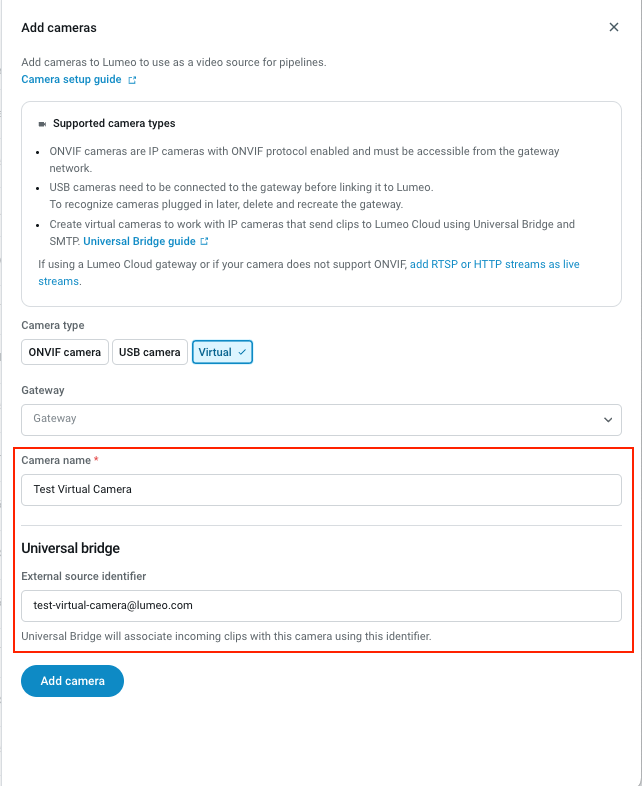
Add a Virtual Camera and set it's External Source Identifier
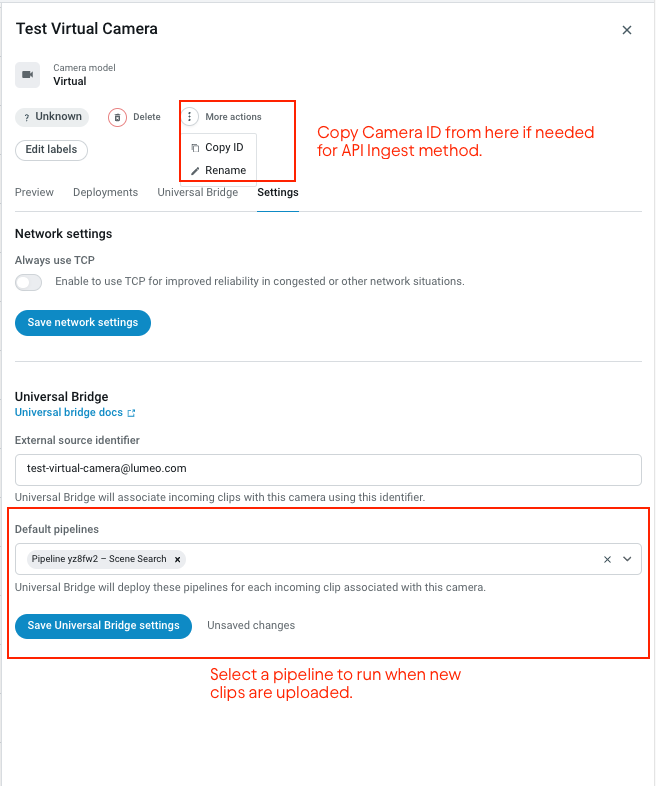
In Camera Settings, set a pipeline to run when new clips are uploaded for this camera.
Ingest
In the next step, start ingesting video clips using one of the connectors below.
SMTP Connector
The SMTP Connector allows 3rd party clients & devices (Cameras, NVRs, VMS', other services) to send video clips to Lumeo using SMTP. When the Virtual camera receives video clips, it saves them to the Lumeo Cloud and runs the configured Lumeo pipeline on it in the cloud.
The SMTP Connector only works with devices and clients that allow specifying a SMTP server to be used to send emails. It will not accept emails relayed from other mail servers.
Configuration
Setting | Value | Notes |
|---|---|---|
SMTP Server |
| |
SMTP Port |
| PlainText Port : Clients connecting over plaintext that support the SMTP STARTTLS extension can issue the STARTTLS command before attempting to authenticate. SSL Port : Clients connecting over this port do not need to use STARTTLS to enable authentication, as this connection is secure by default. |
SMTP Username | Workspace Application ID | See SMTP Authentication Section below. |
SMTP Password | Virtual camera Token | See SMTP Authentication Section below. |
Email Sender (From) | Any unique email address (does not have to be functional). |
|
Email Recipient (To) | Same as From. | |
Subject | Any | Unused by Lumeo |
SMTP Authentication
Uses Virtual camera credentials found in Settings -> Virtual cameras in console.
Username: Workspace ID (found in Settings tab, left nav)
Password: Virtual camera Token (generated and revokable in Settings tab -> Virtual cameras section)
Watch out for Camera limits on Username and PasswordSome cameras may limit the length of the username and password fields and truncate values you enter.
For workspace id / username, Lumeo supports the following to fit in with Camera SMTP username limitations:
- Workspace ID (ex
d4119234-c5cc-4723-861b-b7095ed33e73)- Remove dashes from Workspace ID. (ex
d4119234c5cc4723861bb7095ed33e73)- Base64 encoded bytes of Workspace ID (ex.
zMCQYfjnRd2AH185-QOudA)- Email address with Workspace ID as a prefix and Camera External ID as suffix (ex.
[email protected])
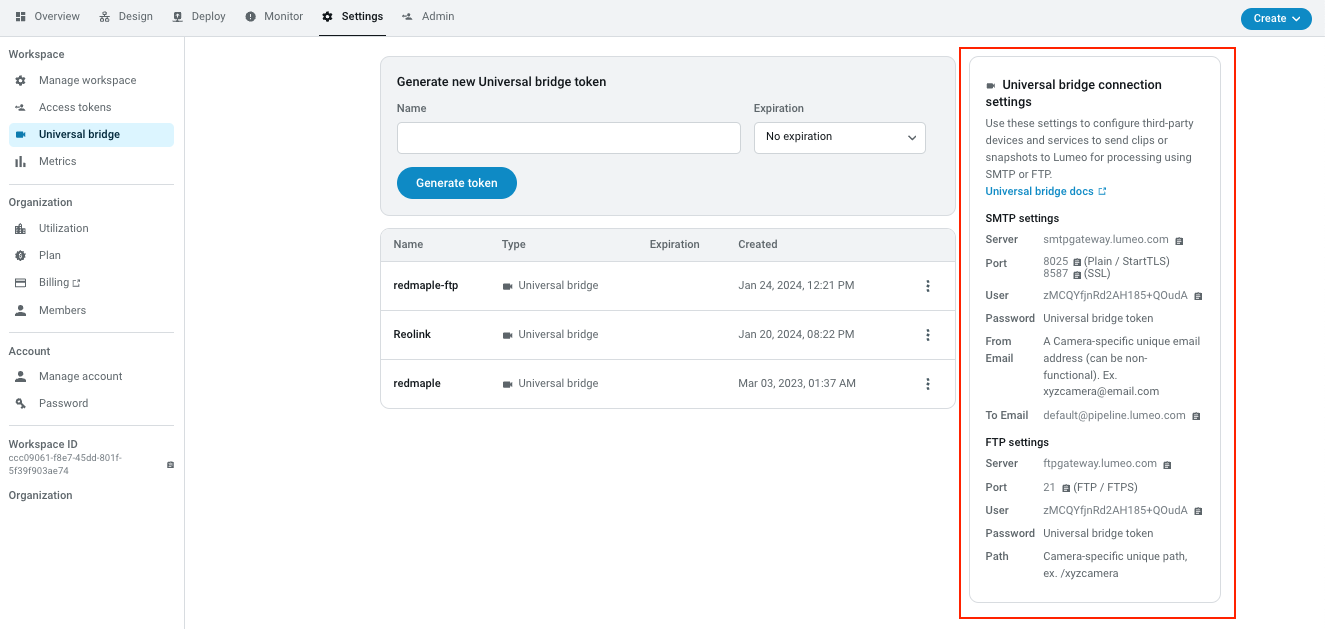
Email Sender
Email "From" address is used to correlate the clip with Cameras in Lumeo. To associate with an existing camera, navigate to the Camera details page and set the External Identifier to the desired email under Virtual camera settings.
If a Camera with the From address is not found, the Lumeo will create a new Virtual Camera in your workspace and assign the From address as it's External Identifier. In this case, the files will be uploaded but not processed till a Default pipeline is set.
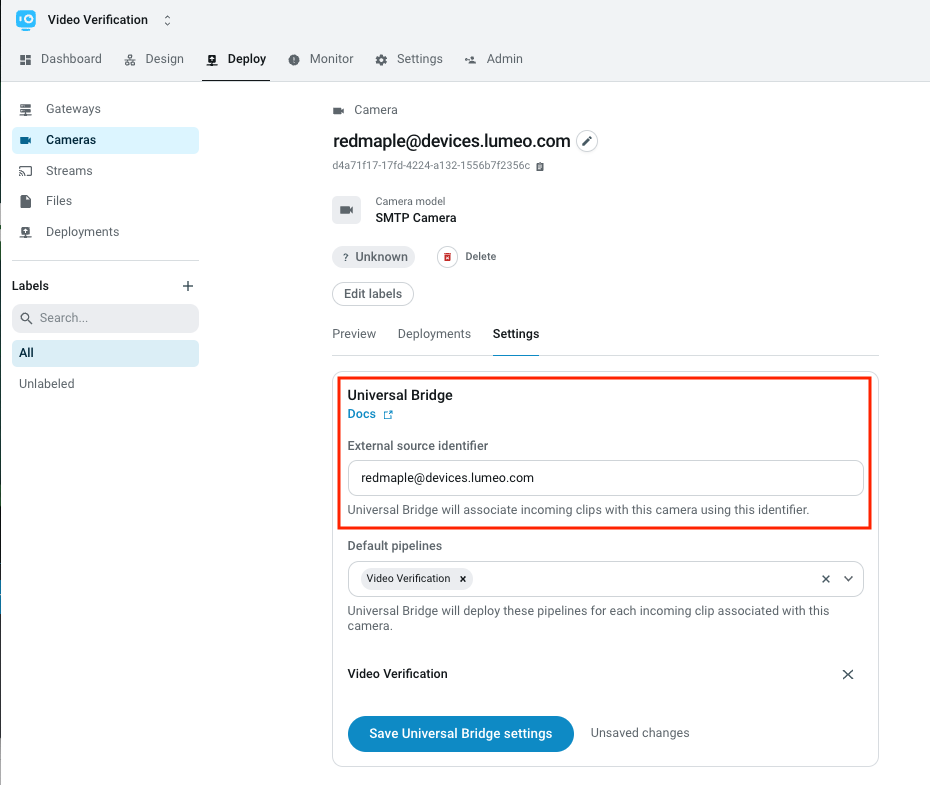
Email Recipient
Email Recipient corresponds to the email’s To MIME header. It should be set to the same value as the Email Sender.
FTP Connector
Coming soon.
API Connector
Uses Workspace ID and API Key credentials found at API, not the Virtual camera token.
Uses the Lumeo API to emulate the Virtual camera capabilities for clip processing, letting you set a per-camera configuration easily using the Console.
Install the lumeo python package (see instructions here API & Scripts). Then run the lumeo-bulk-deploy script.
The API Connector can be used to upload clips using an External source identifier, or using the Virtual Camera's ID.
Processing
When Lumeo receives a video clip, it does the following:
- save it to Lumeo Cloud
- associate it with a Virtual camera that matches the it's External Identifier, creating a new virtual camera if there was no match
- and if a Virtual camera default pipeline is configured in camera settings, queue the clip up to be processed.
A newly created Virtual camera will not process any clips, just save them to the Cloud. In order to start processing new clips, you need to set a Reference Pipeline in the Camera settings. .
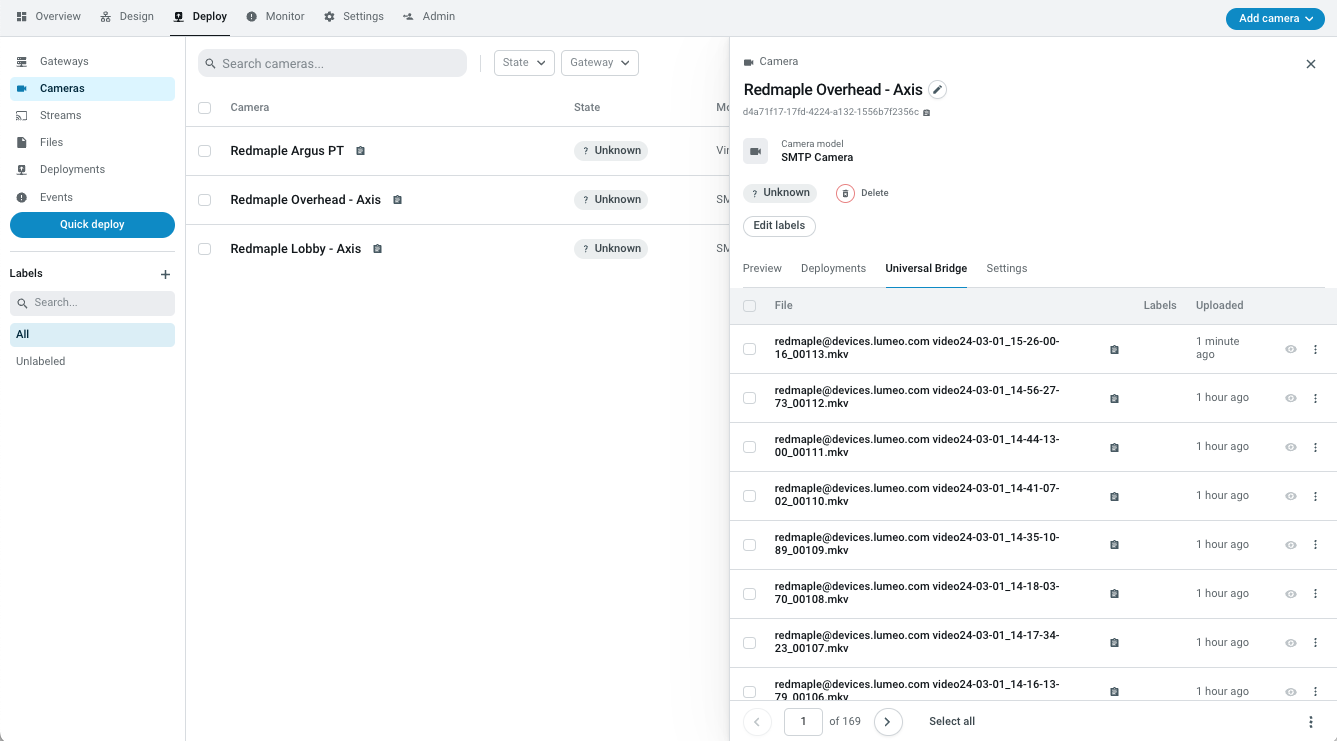
See a list of uploaded clips from the camera -> Camera uploads tab.
Reference Deployments
The first time a clip is processed by the Lumeo for a Virtual camera that has a Reference Pipeline, a "Reference Deployment" is created if one doesnt exist. This is listed in Camera detail -> Settings -> Universal Bridge section.
For future clips, Lumeo creates a new deployment of given pipeline, reusing the configuration of the Reference Deployment of that pipeline, while overriding inputs and metadata specific to the Universal Bridge.
This lets you create a master “Video Verification” pipeline that you can keep up to date (such as by adding a new alert mechanism) — and generates a per-Camera “reference” deployment when the first inbound clip is received. This “reference” deployment can be updated with per-Camera settings such as ROI adjustments, for future clips.
Deleting a Reference Deployment will cause a new one to be created with the next Clip.
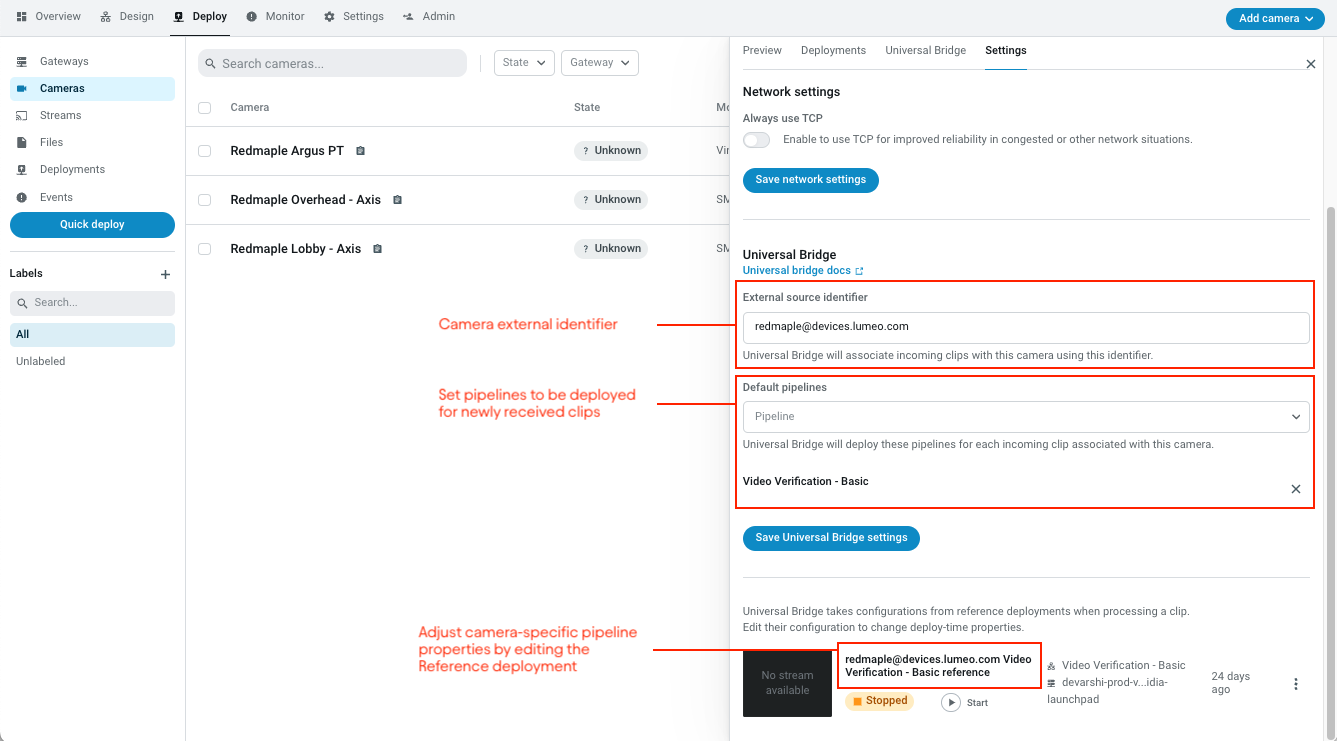
Set default pipeline for the Camera, and edit reference deployment under camera settings.
To set a per-camera configuration for the pipeline, Edit & redeploy the Reference Deployment :
- Click on the Reference Deployment listed in Camera Settings
- Edit the deployment settings by clicking the pencil icon on the Configuration tab.
- Update the deployment and (Optionally) start it after editing the settings to see the updated settings in action.

Update the reference deployment by clicking the pencil icon on the configuration tab of the deployment.
Deployments
Lumeo will schedule new deployments for received clips to be processed on any of the gateways available in the workspace in a load-balanced fashion. Once scheduled, these deployments will appear in the Camera -> Deployments tab.
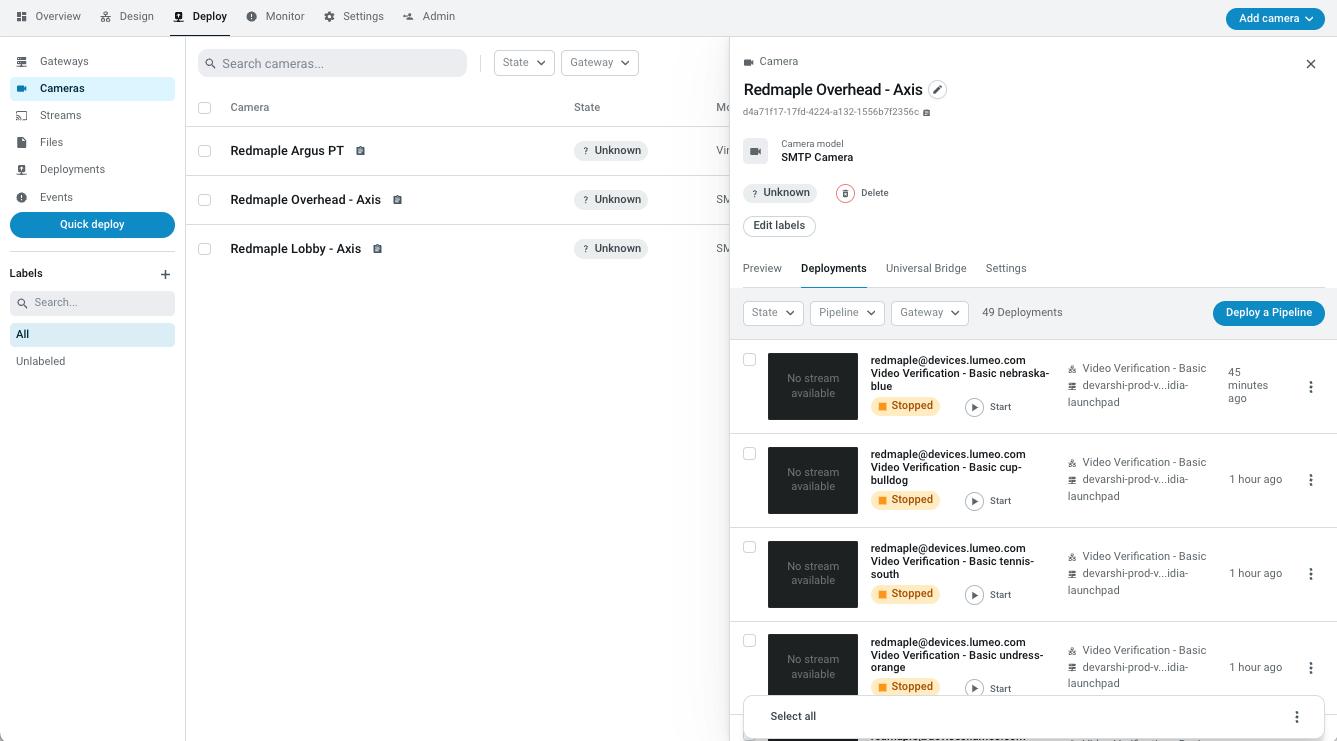
Camera detail -> Deployments tab shows all the deployments created by the Lumeo for that Camera.

Events page shows all the events pertaining to a specific incoming video clip.
Limitations
- Queueing : If all gateways in the workspace have reached their configured max number of the deployments running, the clips are queued at the workspace level to be deployed when a gateway deployment slot is available. During Beta, the status of the queue is not available through Console but available through the Lumeo API.
Troubleshooting
- Unable to be authenticate or see anything happening on Lumeo Console:
- First verify SMTP communication is working by using the test function available on many cameras like AXIS, and check the Events page for events generated by the Virtual camera
- Verify that application ID and application token are correct
- When using the Immix node, the sender e-mail can override the ‘Immix To Email’ to send alarm if the “Enable Virtual camera Override” option is enabled. Additionally at this time there is side effect that if the save clips and sent clips are same length, Immix node may not sent out the e-mail. The solution is to have size of the Immix node clips to be shorter than the original sent clip.
Updated about 2 months ago
